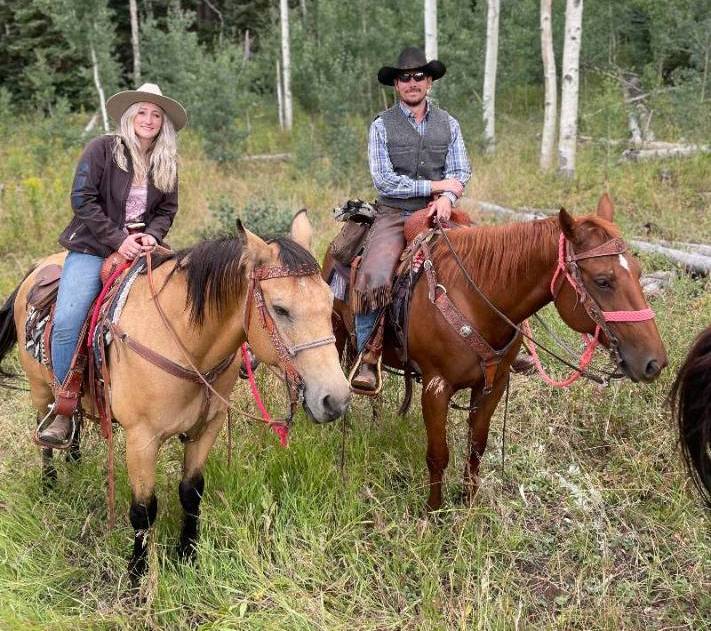Erin and Stith Keiser: Finding Your Own Path to Veterinary Success
In January, Erin Keiser, a WIMU alumna from the Class of 2018, returned to Utah State along with her husband and business partner, Stith Keiser, to discuss how they achieved success in business and veterinary medicine through unconventional means.
The Keisers met when Erin was in her second year of the WIMU program. She already knew she wanted to practice small animal medicine, so after graduating two years later and moving to Stith’s home state of Kentucky, Erin set about finding work with the goal of gaining enough experience to open her own clinic.
While working at a rural practice, Erin started a spay-and-neuter clinic to hone her surgery skills. During the same time, she helped out nearby one-doctor practices, ensuring residents still had access to veterinary care while providing fellow veterinarians with much-needed time off. However, the work soon began to take its toll.
“I don’t know if you’re doing the math,” Erin said, “but I was working six days a week just six months after graduation. It was really hard to say no when someone needed help.”
It wasn’t until almost three years after graduation when Erin took maternity leave for the couple’s first child that she had a chance to reconsider her goals.

“I like to say we got engaged but not married,” said Erin of how close she came to starting her own clinic.
After running the spay-and-neuter clinic and working with local veterinarians, Erin realized she wanted something different for the next chapter of her life. Thinking back to her passion for numbers and math, she realized that veterinary valuations — assessing and understanding the monetary worth of practices and services — could be a more fulfilling use of her time.
By that point, Stith had already spent years pursuing his own interest in the business side of veterinary medicine. Although he’d grown up helping with his father’s veterinary work, his favorite part of the industry was using organization and team-building to serve the community rather than the science of treating animals.
“I told my dad that I wanted to go to veterinary school just like him so that I could lead my own hospital one day,” said Stith. “I’ll never forget that he said, ‘If what you’re passionate about is people and management, why waste your time in veterinary school?' And he was right. People and management are my passion, and I get to focus on that every day in our profession.”
That conversation led Stith to business school and work as a veterinary hospital administrator. He also began to invest in animal hospitals.
“I was, and now Erin and I are, always minority partners in the hospitals we invest in,” said Stith. “It's our job to help lay the foundation for everything non-medical so that the veterinarians we partner with can have a hospital that provides for them and their families and builds something that takes care of their team.”
Investing in hospitals eventually encouraged Stith and long-time friend Dusty Bonner to found Blue Heron Consulting (BHC), which allowed them to focus on helping more veterinarians see their practices flourish without ownership in hospitals. Stith became the company’s CEO, and when Erin found herself wanting a change of pace a few years later, she joined the team as a valuation coach. She also put her DVM to good use as BHC’s director of continuing education. Today, part of her work includes leading groups on horseback into the Teton Wilderness for lessons in veterinary medicine amid the mountains.
The Keisers emphasized how important it is for veterinary workers to identify what they want and need and then act on it. That approach helped Erin and Stith find the right career paths and is key to their continued success. When it comes to investing in hospitals, for instance, Stith believes in being selective.
“As a mentor of ours always said, you only buy the right hospital at the right time for the right price,” Stith said. “We don't have a goal to own X number of hospitals. Instead, we wait for somebody to come along that we want to work with. Then we invest with them and have fun and do a good job.”
Stith and Erin also believe in learning what each community needs from its veterinarians. A rural town, for instance, might have different expectations for veterinary medical care than a big city, and budgetary constraints can vary as well. And just as the Keisers act on their own goals and needs, they also trust clients to advocate for their own interests.
Erin struggled with that trust at first. Like many veterinarians, she felt guilty whenever she suggested an expensive treatment, especially to poorer clients. Eventually, however, she realized that providing clients with the full range of options and believing in their ability to recognize their own needs led to better outcomes for humans and animals alike.
“Clients don’t have to accept your recommendation, and you can always suggest something else,” said Erin. “Plus, you’d be surprised at who can afford what. And when you don't recommend the best medicine, it causes more grief or stress for the owner long term. It's harder to sleep with that at night then just recommending the best thing and then letting them say no.”
Navigating a field as complex and expensive as veterinary medicine has posed challenges for the Keisers. But ultimately, creating opportunities for other veterinarians and local communities has been worth the effort.
“It's not about the ownership in and of itself,” said Stith. “If you've ever played sports, or participated on a team of any kind, you know it's so much more fun to win as a team. That’s what we love most about what we do. For us, “winning” means working together to improve the lives our colleagues, patients and pet owners while building sustainable and profitable hospitals.”

